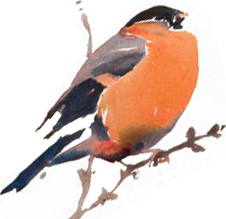Monday 30th April 2018
After a long cold winter and a cool dull spring there was some concern as the date for the outing approached. What would the weather be? Would the spring migrants have arrived? Would anyone want to join the outing?
We needn’t have worried. The weather was a sparkling sunny day with the loch flat calm in the morning. The hoped for birds were there, though maybe in smaller numbers than expected. And we were pleased to welcome a total of 35 attendees.

We all assembled in the Forestry Commission camp site and car park at Sallochy Bay set amongst the beautiful oak woods on the east side of Loch Lomond. This is the quiet side, so different from the busy A82 traffic on the west side of the loch. Those arriving early were greeted by a Nuthatch and a Chiffchaff singing in the trees in the camp site.
After a quick welcome and safety briefing we set off. The plan for the morning was to head north to Ross Wood. This is often the most reliable spot for the spring migrants as it is off the well beaten track of the West Highland Way which closely follows the loch side. We had not gone far before we heard a Nuthatch calling in the trees below the Glasgow University SCENE field research station. Nuthatches have only colonised the east Loch Lomond woods in the last couple of years but have been regularly seen and heard this year. Good views were had of a Nuthatch prospecting a nest hole while another bird was perched close by.

Heading on, a brief snatch of song from some distance ahead gave away the presence of a male Pied Flycatcher. A bird, the first of the year at this location, had been seen at this spot the previous day. After a few minutes of listening and searching we managed to zone in on the singing bird which eventually perched for a while right above the track. Our next target species, Wood Warbler, was quickly located by its distinctive song and good views were obtained of a bird quite low in the trees. The remainder of the walk through Ross Wood gave sightings of more Wood Warblers as well as the more common Willow Warblers, Blackcaps and a multitude of Blue Tits. Some of the group located a pair of Redstarts. Tree Pipits were heard but were always distant and could not be located. A singing Garden Warbler provoked the usual controversy regarding its identity.

We ended our walk at a secluded shingle beach which provided a pleasant resting spot. On the offshore rocky islets there were nesting Common Gulls, Lesser Black-backed Gulls and Canada Geese. A Common Sandpiper was heard nearby but evaded being seen. A pair of Ravens nest somewhere on Ross Point and a bird could be seen and heard calling from the tall trees on the rocky point. We returned by the same route locating again the singing Pied Flycatcher. At the camp site car park we enjoyed an open air lunch at the picnic tables.
The plan for the afternoon was to head south from the camp site to Sallochy Woods trying again for the same species as before. This was perhaps not the best time of day to be searching for the birds and as a result it was somewhat quieter than hoped for. However, we did locate two singing male Redstarts which eventually posed nicely giving some good views and photo opportunities. A Wood Warbler was heard singing and a Tree Pipit was distantly glimpsed. A Common Sandpiper showed itself briefly on the water edge. We returned to the starting point by the same route to end the outing.

In conclusion, those expressing an opinion seemed to have enjoyed the day. The group size was probably bigger than could be conveniently managed. We did consider splitting the group in to two but it was felt that this would spoil the social aspects of the day. A total of 33 bird species were recorded on the day.
Ian Fulton, SOC Clyde Branch Secretary and with thanks to David Palmar for kindly allowing us to share his images of the day.



